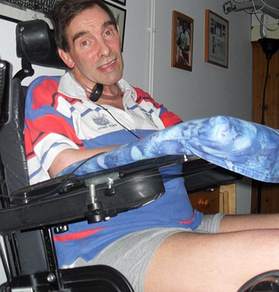Locked-in syndrome
What is Locked-in Syndrome?
Locked-in syndrome is an uncommon neurological problem described as full paralysis of voluntary muscles in the entire area of the body with the exception of eye movement that the individual can still control. It may possibly the consequence of brain injury, circulatory system diseases, diseases that tear down the myelin sheath covering the nerve cells, or drug overdose. Patients with locked-in syndrome are aware and are still capable of thinking and reasoning, but incapable of speaking or moving. The problem will lead individuals to turn out to be absolutely mute and paralyzed. Communication may be doable with blinking and eye movements.
Having a locked-in syndrome is really difficult for the individual and with his or her family. Especially that the patient will become bed ridden and will be incapable of speaking. Despite the problem the family should just have to take into consideration that the individual is still aware of his or her surrounding and can still think and reason. He or she may communicate using blinking and eye movements. In some cases, numerous therapies shows that function can still be slowly regained.
Signs & Symptoms
Symptoms of locked-in syndrome include the following:

Picture of voluntary muscle dysfunction in Locked-in syndrome
- Full incapability for voluntary muscle control except eye movements and blinking
- The patient can still think, reason and remain conscious and aware
- Usual sleep and wake cycles are preserved
- Not capable of speaking
- Paralysis of lower extremities, lower cranial nerves and voluntary muscles
Due to the following symptoms of locked-in syndrome the patient required full care in a hospital or in a home setting.
Causes
The common causes of locked-in syndrome are the following:
- Traumatic brain injuries caused by stroke, severe head injury or ruptured aneurysm
- Diseases that tear down the myelin sheath surrounding the nerves, drug toxicity
- Any neurologic problem that can involve the ventral pons in the brain, which is the one responsible for voluntary muscle control
Treatment
As of now there is no known cure or surgery for locked-in syndrome. The management for the problem is only supportive care. They are taken care of critical care specialists, doctors of neurology, and physiatrists. They can also be supported by
- physical therapists
- occupational therapists
- speech and language therapists and
- psychotherapists.
Prognosis
The prognosis for locked-in syndrome is poor because there is no known cure and no standard treatment. In some cases therapy can help patients to regain their function. Despite the general poor prognosis there are still cases of locked-in syndrome who have regained impressive improvement of function with the help of new technologies like augmentative communication technology.
Now that there are new hopes for locked-in syndrome, families of the patients should not give up and maybe sometime in the future therapy could really help majority of the patients for their improvement and slowly return to their productive life.